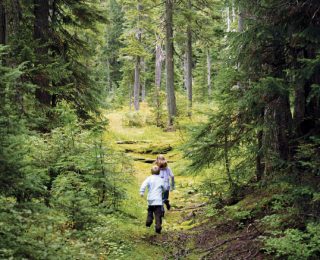
Jen O’Loughlin is a Physical Therapist, a Doctor of Physical Therapy, and a Board-Certified Pediatric Clinical Specialist. She has experience in various pediatric clinical settings such as: Inpatient Rehab, the Neonatal Intensive Care Unit, Aquatics, and the School System. She is currently working in a hospital-based system in Portland, Oregon.
TLJ: Jen, how did your healthy movement story begin?
JOL: At a very simple level, when I started in college doing a little more job shadowing, Physical Therapy was the thing that I could see myself getting excited for every single day.
“I would be OK doing this every day for the foreseeable future and if I feel that way it seems like a pretty good path to go down”
Since then through PT school and my first few years of practice, I found I can look back a little more clearly, and now realize other reasons why I was drawn to PT. I really enjoy the prolonged amount of time I get to spend with families. I get to kind of travel on this journey with them to help problem solve things and achieve goals and meet these milestones.
“It’s really awesome to have a job where every day I get a chance to have an impact on someone and their life and their family’s lives”
I appreciate being able to do a little bit of good, or I try to do a little bit of good each day. Sometimes it feels like everything else in the world isn’t so positive, but the decisions I make and what I get to do on a daily basis have a chance to counteract that.
TLJ: When you spent time in the school system working as a school Physical Therapist, what were some of the issues you dealt with?
JOL: It would depend on the kid and their specific needs. Depending on the age of the child, if the child is under three you have federal services through an Individualized Family Serve Plan (IFSP) and then typically after 3 sessions it transitions to your traditional Individualized Education Program (IEP). So, if a child qualifies for physical therapy on their IEP, that can look very different depending on the child; but typically, PT as a related service on those IEP’s aims to help those kids access the school environment to best get their academic needs met. Whether that is the right positioning set up in a chair in the classroom, helping out in PE, or making recess and playground toys accessible; it covers a whole bunch of areas.
TLJ: In regard to seating in the classroom, what challenges did you notice?
JOL: Sometimes you know exactly what you want, but it is not readily available for you. Schedule-wise as a school therapist, you might be in a classroom with a specific student anywhere from 1 to 4 or 6 times a month. Trying to schedule getting the appropriate chair from a traditional durable medical supply vender that you want and need can take so long.
“It can be a scheduling nightmare”
Sometimes if you don’t get what you want, school physical therapists are very ingenious and are good at adapting, possibly by adding cushions to existing seating in the classroom. We will strategize with teachers in general education or para-professionals to specifically meet what that child’s needs are and get them set up in the classroom.
TLJ: What is your opinion on physical education in schools today?
JOL: It appears that there is a higher emphasis on test scores and a strong focus on passing benchmarks now. So, what do we give up during the school day… Unfortunately, recess and PE are time out of the classroom, and sometimes they get the short end of the stick. It is best for children to get periodic gym or gross motor breaks to go run and have physical activities, and then they will be able to sit and attend with higher attention levels for 30 to 60 minutes. The APTA’s vision is to optimize human movement to improve the human experience. In the pediatric section of the APTA, they have groups that work with lobbyists to push forward the physically active agenda.
“It is beneficial for everyone across the board”
TLJ: With all the varying information online on how much physical activity we need, what do you think the best take away is in regard to healthy movement for the average person?
JOL: Along the physical activity guidelines- Health.gov releases a compendium of physical activity guidelines for Americans. According to the new 2019 guidelines, it states that even if you are just doing ten minutes of activity it counts. Little aggregate bouts of movement throughout the day toward your movement goal gives the immediate benefits of building muscle strength and bone density and reduced risk of heart disease.
TLJ: What issues are presenting themselves in your practice with the current lack of movement in our day to day lives?
“You are 8 years old and you should be running around for at least 60 minutes a day, not sitting in a chair that facilitates a poor spine position and not moving for hours on end”
JOL: There are now more issues because a lot of our workplace is valuing long hours, high productivity, lots of time spent at your desk, and high stress situations. There is a connection between tense muscles in your upper shoulders and neck, and stiffness in your lower back and prolonged sitting time.
What we found, and the way it impacts me; I’m not seeing the middle age CEO who may be on the phone all day. I am seeing kids between 8 and 15 years old. When they come home from school after sitting the majority of the day, and they sit in their bean bag chair playing video games the rest of their day, then they tell mom that their neck or their back hurts. Mom and dad don’t know what to do or don’t make the connections that you are 8 years old and you should be running around for at least 60 minutes a day not sitting in a chair that facilitates a poor spine position and not moving for hours on end.
“Oh, I sat a lot today, my back hurts”
One of the things we are seeing is that if parents don’t have coping strategies for their own aches and pains then kids are picking up on that vocabulary and that thought pattern. They hear, “Oh, I sat a lot today, my back hurts” and “this is something that’s a big deal, I don’t know what to do.” Then it becomes this thing of we don’t know how to address it. Where sometimes just kind of moving around or some gentle stretches or a better seating position are all strategies that can help.
I think my parents being very active and very open about verbalizing, “well my body feels this way but it makes sense that it feels this way because I was doing this, and this is what I am going to do to make it feel better.” Hearing that thought process, I think has impacted how I personally deal with my own aches and pains or when I am just tired. This has been a question I ask families now, too, when I have an initial meeting with them.
“They shouldn’t know what low back pain feels like because they are very young and healthy”
It is hard if you are a kid in late elementary school; you don’t, unless you have broken a bone or had a bad fall, know what pain is to you. They shouldn’t know what low back pain feels like because they are very young and healthy. These are tricky cases because there is a lot of discussion about what is happening, and the philosophy of pain and pain education. In the end, you are not only helping the child that you are seeing, but you are also helping the whole family and what their relationship to pain is and what the narrative at home is too.
TLJ: What is your experience with rockers in helping with pain or easing the nervous system?
JOL: I have had multiple patients where before I’m able to do any productive balance work, direction following, or sequencing for coordination activities; they need that linear rhythmic input from either a rocker chair, or sometimes we will do a swing in our sessions to start out. When children need that input, it is a stark difference before and after on what they are able to do successfully.
TLJ: Jen, where do you think we are headed with healthy movement?
JOL: My sense of where Pediatric Physical Therapy is going in terms of how we advocate for healthy movement, is how do we make healthy movement and physical activities accessible and inclusive for all across the board. For instance, making sports games sensory friendly, making playgrounds all accessible, and making PE more of an inclusive activity. Not just having an adaptive PE class at this time, and then have other PE classes at other times; but making it where everyone can participate, because then everyone is having those same social and physiological benefits. And why would it not be inclusive?
TLJ: How does healthy movement play out now in your personal life?
JOL: Work is and can be very physical. I really enjoy hiking, running, and outdoor exploring physical activity. But I have had to incorporate more gentle stretching and yoga too. As some days I get home from work and I am exhausted, because I was helping five teenage kids do some very heavy tasks and my body is tired. I have found an appreciation for more intentional slower movement. It’s about finding ways so that I am still moving my body.
“I have found an appreciation for more intentional slower movement”
TLJ: If someone wanted more information on healthy movement, where would you direct them?
JOL: Health.gov has tabs on food and nutrition, physical activity, health literacy, and things like that. The CDC also has wonderful handouts on milestones for infants, children, and teens. They give these milestones to look for in terms of social, emotional, movement, and language milestones. Also, they give you ideas on how to facilitate meeting those milestones with your child. I have found those very helpful. The Academy of Physical Therapy APTA has some resources for parents as well.
Jen, thank you for sharing your story.


